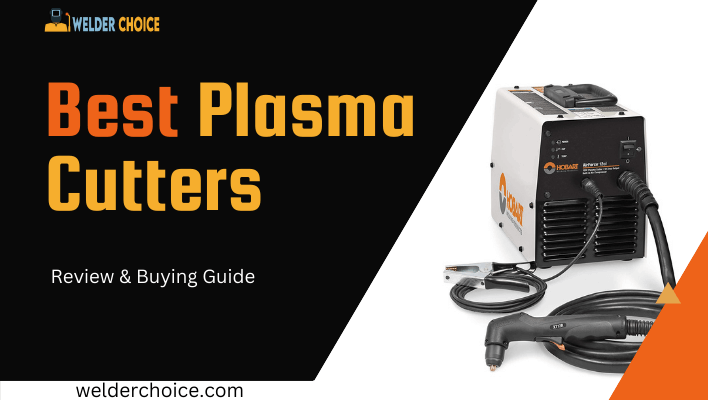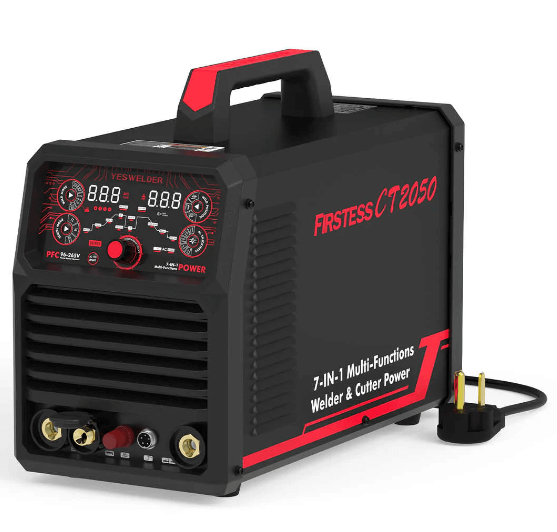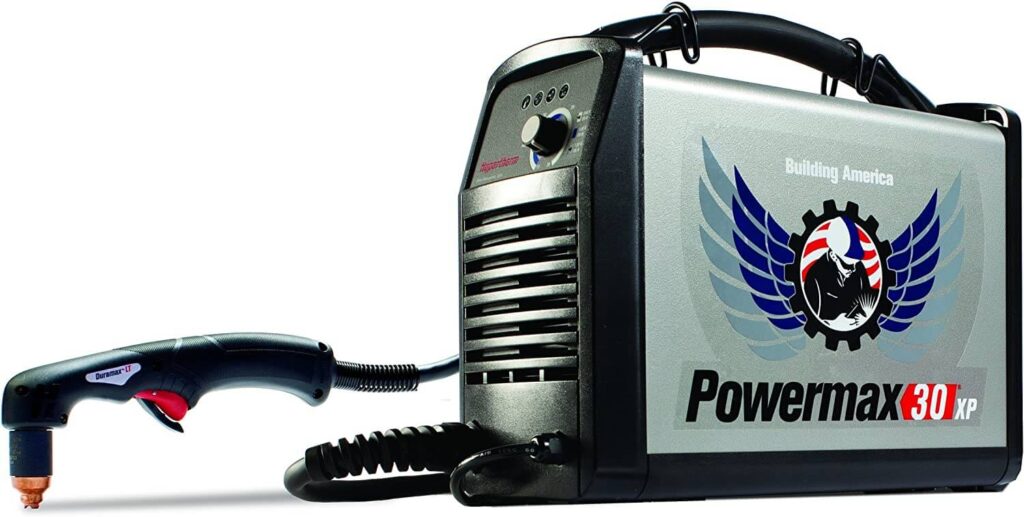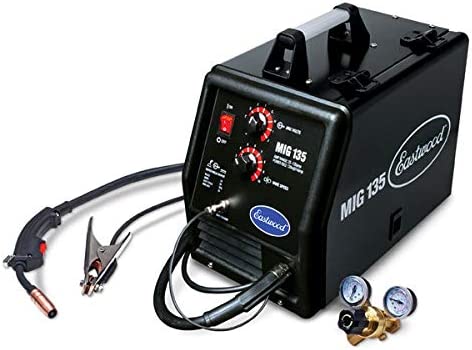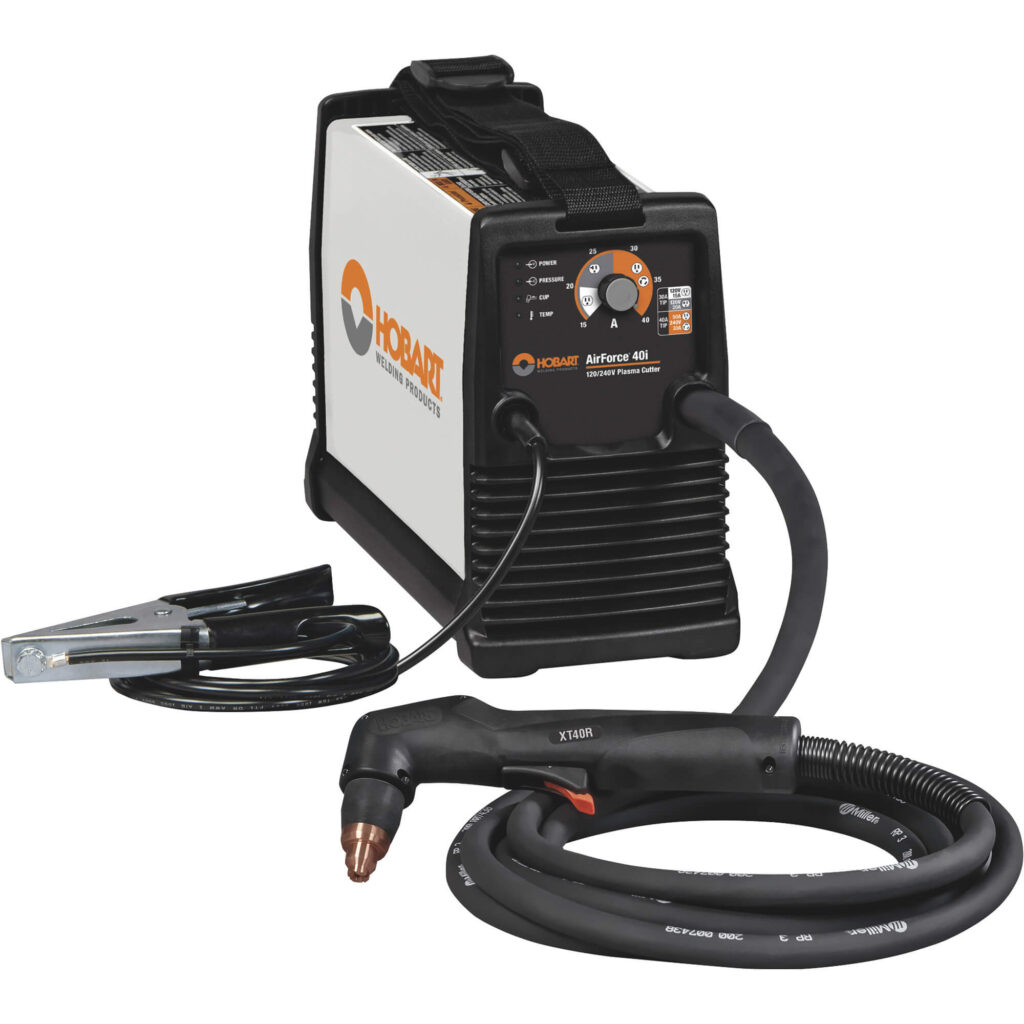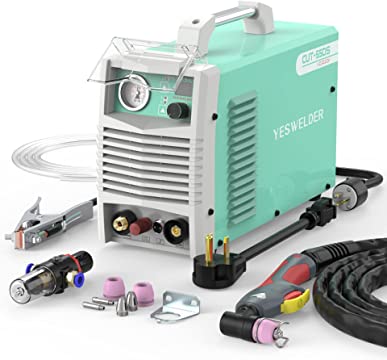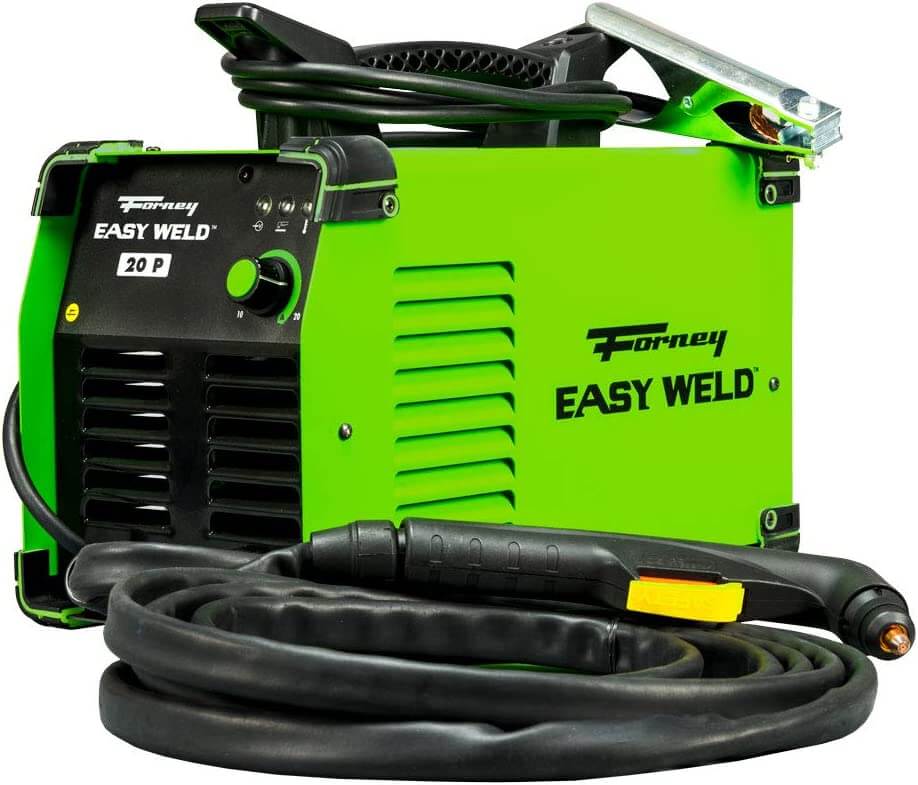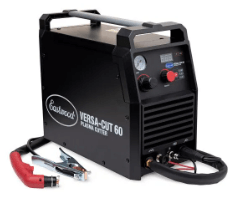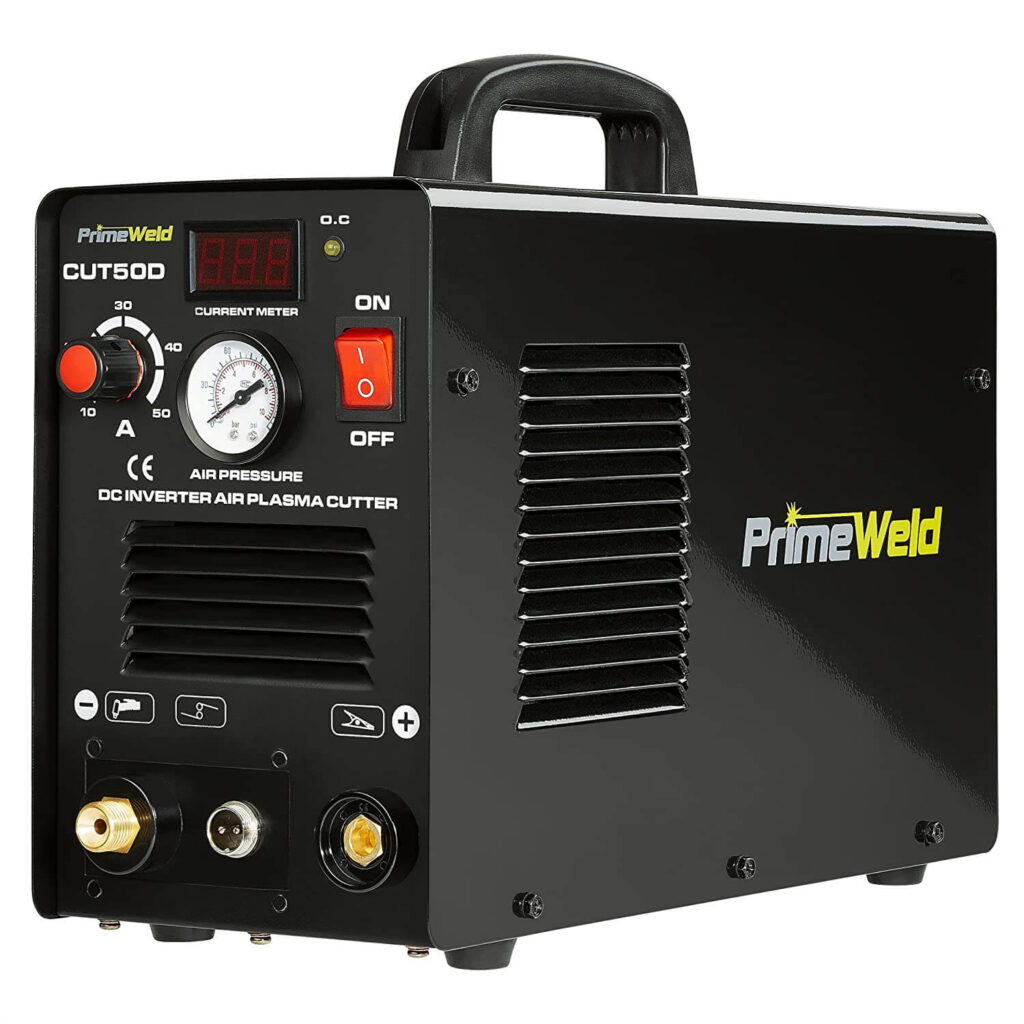Being new to plasma cutting might be highly perplexing due to the wide variety of best plasma cutters available.
Which models should be placed in the back of the class and which ones are the best in the class? Research is necessary to get the best plasma cutter for you.
You wouldn’t want to buy the incorrect model, would you? Especially considering the price of some of these plasma cutters. Thankfully, I’ve got your back since I’ve tested a ton of cutters to determine which ones you can trust and what specific tasks they are best suited for.
Check out the top ten plasma cutters that are affordable to see for yourself. Every project and every budget can find something here. You may locate a cutter that will enable you to cut confidently without spending more than you have to, no matter what you are working on.
Top Best Plasma Cutters
Here we listed the best plasma cutters for your convenience.
1. YesWelder Firstess CT2050 Powerful 7-in-1 Cutter
2. Hypertherm Powermax-30 088079 Plasma Cutter
3. Eastwood Versa Cut 40 Plasma Cutter
4. Hobart 500566 Airforce 40i 240 V Plasma Cutter
5. YesWelder CUT-55DS 55Amp Arc Plasma Cutter
6. Hobart AirForce 12ci Plasma Cutter with Built-In Air Compressor
7. Forney Easy Weld 251 20 P Plasma Cutter
8. Eastwood Versa Cut 60 Plasma Cutter
9. PRIMEWELD Air Inverter Plasma Cutter
10. YesWelder FIRSTESSTM MP200 5-in-1 Welder & Cutter
Best Plasma Cutters Reviews
The best plasma cutters are listed below. Each is intended for a distinct task and set of users. A hobbyist might require something more reasonably priced, but a welding business will require performance and durability.
There are numerous cutters below, though, that are designed to meet the requirements of DIY hobbyists and pros as we are discussing the best possibilities on the market. You won’t likely choose incorrectly if you choose your machine based on your needs and budget.
1. YesWelder Firstess CT2050 Powerful 7-in-1 Cutter
Excellent 7-in-1 multi-process welder that combines welding and plasma cutting is the YesWelder Firstess CT2050. As a result, in addition to cutting, you can also TIG weld sensitive metals with this machine, making it a versatile option for your small shop.
The CT2050 is a dual voltage welder with integrated PFC technology that can operate with a wide input range of 96-265V. Although this cutter is dual voltage, it performs best when plugged into a 220V outlet.
The YesWelder CT2050 has a 12-45 amp rating at 220V and a 12-25 amp rating at 110V. I was taken aback by the 100% duty cycle rating at full power, which allows for longer cuts. The maximum clean cut is set for 25/32′′ at 110V and 1 3/16′′ at 220V. You can cut up to 19/32′′ severance thickness if you put enough effort and dedication into it.
I like the built-in air compressor, but for the best results, you should use an external compressor if you have confidence in your gear. A moisture separator is also included, keeping moisture out of the cutting system.
A non-contact pilot arc with a blowback start is used by the plasma torch. Because of this, cutting soiled, painted, or rusted metals won’t harm the consumables. Furthermore, because there is no high-frequency, you can use your cutter with a CNC table or other electrically sensitive equipment. Although the torch is cozy, the supplies it comes with won’t last too long.
The CT2050 is also capable of AC/DC TIG, Pulsed TIG, and Stick welding in addition to plasma cutting. Today, it is uncommon to encounter a multipurpose AC/DC TIG welder that is also a plasma cutter, therefore this purchase is well worth it. The hefty TIG lamp and welder’s total weight may not be to everyone’s taste. This plasma cutter is not the lightest on our list at 61 lbs.
Pros
- Non-touch pilot arc for corroded, painted, and filthy metal
- Utilizing PFC technology and two input voltages
- able to function with an internal or external air compressor
- A clean, efficient, and dross-free cutting procedure
- Suitable for a CNC table blowback start
- Suitable for Stick, AC/DC TIG, and pulsed TIG welding
Cons
- Ideal with 220V input
- Rather immobile
Specifications
- Plasma cutting, AC/DC TIG, Pulsed TIG, and Stick are all processes
- Cutting Thickness: 19/32′′ @ 220V severance, 1 3/16′′ @ 220V clean cut
- Materials that can be cut include steel, stainless steel, mild steel, aluminum, etc.
- Voltage input: 96-265V, 50–60 Hz.
- First phase of input.
- AC/DC current.
- 45A maximum output
- Rated Output: 100% duty cycle at 45 A (can cut for long without overheating)
- Weight: 61 pounds
- Dimensions: 21.65 inches by 16.92 inches by 14.96 inches
- Required Pressure: 5-7 CFM
2. Hypertherm Powermax-30 088079 Plasma Cutter
The pricing of the Hypertherm Powermax-30 reflects the outstanding quality and durability of these heavy-duty Hypertherm plasma machines.
But it differs from inexpensive plasma cutters with extensive capabilities, which makes it a favorite.
As one might anticipate, this cutter allows a dual input voltage. Powermax 30XP has a very long (15 feet) torch lead and is incredibly lightweight.
For a 1/4″ steel plate, the power source has outstanding turn off capability, and the cuts are of very high quality. As it cuts 1/2 in at 10 ipm, you also obtain extremely good cutting speeds.
There is no need to search any further if you want a handheld plasma cutter that can support delicate work and sculpture; it is the highest-quality option in my reviews of cutters. Because of the exceptional quality, the plasma cutter price is reasonable given what you get.
But unlike some other Powermax versions, it won’t gouge, and some people might find the fact that it’s not a 50 amp plasma cutter somewhat restricting. So, while you can’t cut through the thickest materials with this plasma cutter, it still has amazing efficiency and is a top choice.
Furthermore, according to some owners, you shouldn’t think of the Hypertherm Powermax 30 as a professional cutter because repeated use could harm the internal water separator and potentially lead to leaks. Still, for small fabrication tasks and projects, this is a high-quality plasma cutter. We advise Hypertherm Powermax45, the big brother, for industrial application.
The Hypertherm Powermax 45, on the other hand, is a true workhorse and a professional cutting machine that is incredibly portable and lightweight. The best feature is that a tiny fabrication firm may connect it to the CNC table. High-end plasma machines pay for themselves quickly, despite the additional cost.
Pros
- Dependable for prolonged use
- A skilled plasma torch
- Made by a renowned business in the field
- Dual volt outlets are supported by powermax30 xp, and plug adapters are available.
- Includes everything you need, including a shoulder strap, trigger safety gear, and standard and fine cut consumables for every detail.
- Furthermore provides a premium drag tip for increased consumable durability
- Effortless cutting
- Most likely the best option for a small fabrication firm
- Portable plasma cutting machine that is light-weight
Cons
- Price
- Not intended for continuous heavy use.
Specifications
- Cutting with a plasma torch.
- Steel may be cut to a maximum thickness of 5/8 in and a tidy cut of 3/8 in.
- All metals, including steel, stainless steel, aluminum, etc., are cuttable materials.
- 1/2 inch at 10 inches per minute for cuts
- Voltage input: 120/240 V, 60 Hz.
- First phase of input.
- Present: DC.
- 30A maximum output
- Rated Output: 120V at a 20% duty cycle and 240V at a 35% duty cycle
- Weight: 21 pounds
- Dimensional information: 14 x 5.5 x 11.5 inches.
3. Eastwood Versa Cut 40 Plasma Cutter
Another excellent hobbyist, auto restoration, and light fabrication plasma cutting machine developed by Eastwood Versa Cut 40. This plasma cutter requires 5-7 cfm of air at 60 psi to operate and may be powered by either a 110V or a 220V input.
You can utilize this metal cutting machine at your garage, house, farm, ranch, or remote job site thanks to the supplied versatility.
Additionally, a typical external air compressor in your shop can supply the necessary air pressure. I was astonished by the amount of power needed to cut through metals up to 3/8″ thick, which is rated at 40 amps. Eastwood Versa Cut 40 can be used to cut through sheet metal as thin as 24 ga.
Despite the fact that Eastwood is a US-based firm, Versa Cut 40 is made elsewhere, namely in China. However, manufacturers assemble products in accordance with corporate specifications and standards, so you obtain a dependable product. A 3-year warranty, which is very popular in the hobbyist sector, serves as proof of reliability.
Overall, for the money spent, you get a great and affordable plasma cutter. A comfortable torch with a 20-foot lead that can cut any electrically conductive metal is also included in the package content. With its non-touch technology, it is ideal for cutting painted or rusted metal.
The box material for Eastwood Versa Cut 40 looks to be a little lacking, so if you intend to use it frequently, you should buy extra consumables. Fortunately, the torch works with common consumables that you may buy at your neighborhood welding shop.
Pros
- Power and versatility are increased through inverter technology.
- Plasma machine with dual voltage
- Excellent for DIY enthusiasts, hobbyists, and automotive cutters
- an easy-to-hold torch with a lengthy, well-insulated lead
- Decent performance in metal cutting
- The demands for compressed air flow are not very high.
- three-year guarantee
Cons
- There are not many consumables in the box.
Specifications
- Cutting Capability: The maximum cut for 24 ga is 3/8″.
- Steel, stainless steel, or aluminum are all cuttable materials.
- Power input: 110V/240V, 60 Hz.
- Single phase for the input.
- Direct Current as the Current Type
- Requirements for airflow: 5-7 cfm @ 60 psi
- 40A maximum output
- 60% of rated output at 40 amps
- 36 pounds of weight.
- Dimensions: 16.5 inches long, 8 inches wide, and 13 inches tall.
4. Hobart 500566 Airforce 40i 240 V Plasma Cutter
Hobart is one of the major manufacturers of welders, and the pricing range of the Hobart 40i Plasma Cutter reflects this. However, it cuts mild steel at a pace faster than an oxy torch at 7/8′′ at 50% duty cycle! This is a serious gadget that merits your consideration among plasma cutters.
Remember that the older Airforce 40i models were 240V only devices rather than 110V/220V dual voltage plasma cutters, thus you’ll need to add an appropriate power source, which is costly.
The most recent upgrades, however, come with the distinctive Hobart MVP plug, allowing you to use both 110V and 220V power sources.
One of the best plasma cutters I’ve tested is the Hobart Airforce 40i, and I really appreciate how the airflow has been planned to be as energy-efficient as possible. This feature offers a great deal more freedom than the majority of air plasma cutter tools do. The duty cycle is respectable, and the torch is automatically post-cooled, increasing the life of both the torch and the consumables.
With the most recent upgrades, you can use this machine in a remote site location, a ranch, a farm, a garage, or at home. Additionally, 40i shines when you frequently need to slice through a heated metal object in the same way as a knife slices through butter.
You definitely get what you paid for, even though it can be more expensive than more affordable solutions like LOTOS LTP5000D, Primeweld, or Eastwood. An industry-leading 5/3/1 year warranty offers excellent protection for your investment.
The Hobart Airforce 12ci plasma cutter, the weakest of the line’s three primary modes, should be taken into consideration if you are a beginner seeking for a more affordable choice. Since this machine includes a built-in air compressor, using it is really simple. It is best suited for cutting sheet metal, so you shouldn’t anticipate any heavy-duty cutting.
Pros
- Robust case
- Excellent for professional shops and jobs
- Using a wind tunnel (protects internal components)
- Xt40r torch accessories and consumables
- On-demand cooling system with fans
- An organization with a strong reputation is made in the us.
- Thanks to high temperatures, cuts through metals quickly.
- A productive airflow
- Compact and lightweight dimensions
Cons
- Expensive
Specifications
- Cutting with a plasma torch.
- Steel 5/8-inch clean-cut and 7/8-inch maximum cutable thickness.
- Cuttable Materials: Brass, aluminum, steel, stainless steel, etc.
- Voltage input: 120/240 V, 60 Hz.
- First phase of input.
- Present: DC.
- 40A maximum output
- Rated Output: 50% duty cycle at 40 A
- Thirty one pounds.
- Dimensions: 17.75, 18.25, and 11.63 inches
5. YesWelder CUT-55DS 55Amp Arc Plasma Cutter
I adore this plasma cutter, and it’s unquestionably the best tiny plasma cutter you can get for the money. It has a lot going for it and is reasonably priced (it’s not the cheapest plasma cutter for sale on the market, but it’s not far off).
YesWelder Cut 55DS has a non-touch feature that makes it incredibly simple to cut through rough or painted metal without generating copious amounts of waste. A continuous pilot arc also prolongs the life of your nozzle, saving you money on maintenance costs.
Give it a try and, if you’re not satisfied with your YesWelder, send it back for a refund; they want to make sure you’re delighted. The 30-day money-back guarantee is also really amazing.
In my tests, it was the most affordable plasma cutter. The built-in components are reliable and sturdy, and the company’s customer support is helpful and there when you need it.
The dual-voltage capability is a useful feature since it allows for excellent cutting performance on almost any metal. You can cut sheet metal up to 12 gauge thick with the 110V input, but if you need to work with thicker stock, you can always convert to the 220V plasma cutter mode. Although the manufacturer specifies a maximum severance thickness of 3/4 inches, most owners advise against cutting metals that are thicker than 1/2 inches.
Try it out and send your YesWelder back for a refund if you’re not satisfied with it. The 30-day money-back guarantee is also really amazing. Owners’ experiences with customer service varied, but most concur that they tried their best to address a problem. You also receive a 1-year warranty, which is excellent for this price, in addition to the return policy.
In my experiments, the Cut Yeswelder 55DS plasma cutter has proven to be the best value, and for good reason. This plasma cutter is transportable and weighs 19 lbs. Built-in components, however, are reliable and sturdy. Although the included accessories may seem inexpensive, the torch will function as intended. Nevertheless, you shouldn’t rely on the instruction booklet because it is essentially useless.
Pros
- Non-contact cutting technique
- For further adaptability, use two input voltages
- This plasma cutter is really powerful.
- Operates by consuming air (for pressure)
- Includes an air filtration system (air regulator/air filter), an air hose, a 13-foot pilot arc technology torch, a 10-foot work lead, and consumables.
- A clean cutting procedure for various metals
- With the push of a button, it is simple to use and has an amp reading screen.
- Compact and lightweight for travel to a job site
- Switch technology
Cons
- There may be a larger display.
- Cutting power can be a little bit less than stated.
- The user guide is ambiguous.
Specifications
- Cutting with a plasma torch.
- Metal can be cut with a maximum cut of 3/4″ and a clean cut up to 1/2″ thick.
- Materials that can be cut include steel, stainless steel, mild steel, aluminum, etc.
- Voltage input: 110/230 V, 60 Hz.
- First phase of input.
- Present: DC.
- 55A maximum output
- Rated Output: 60% duty cycle at 55 A (can cut for long without overheating)
- 34 pounds in weight.
- Dimensions are 16 x 6.29 x 11 in.
6. Hobart AirForce 12ci Plasma Cutter with Built-In Air Compressor
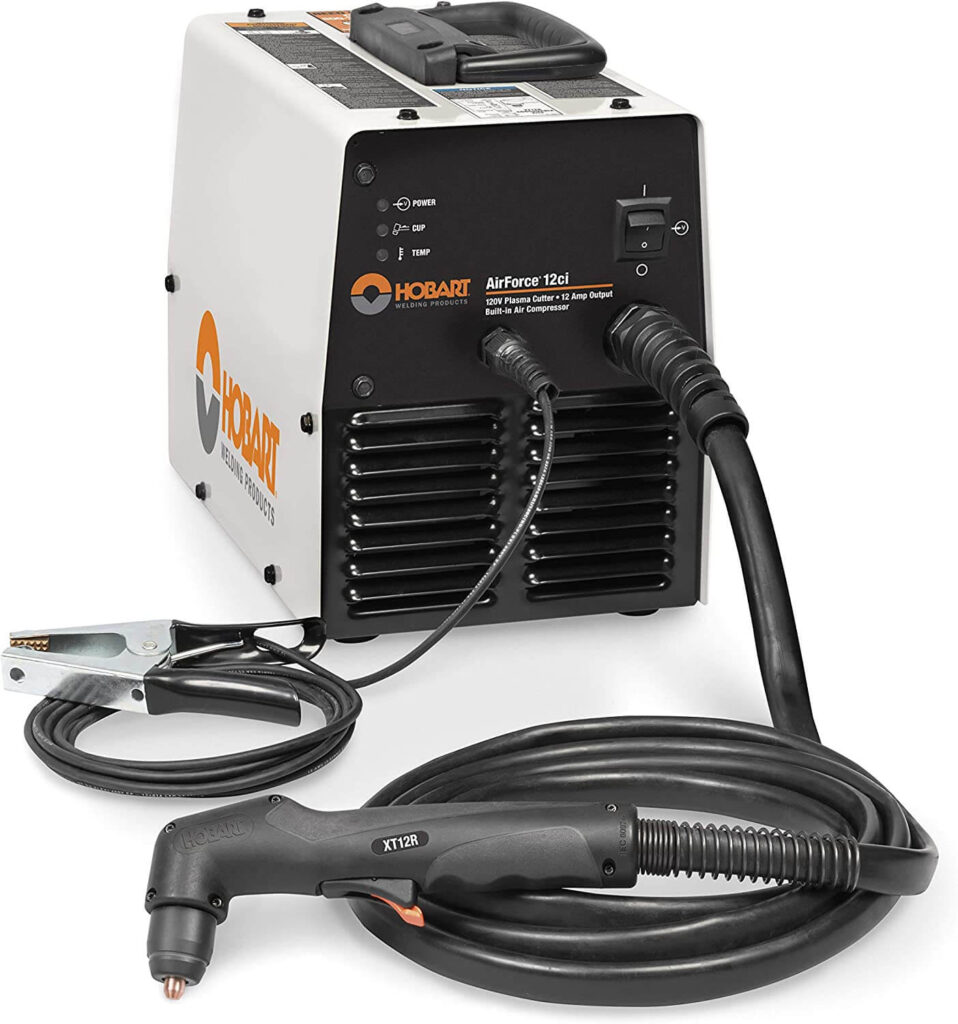
Key Features:
- Voltage input: 120 V at 60 Hz.
- Single phase of input.
- Direct current is the current.
- 12A maximum output
- Rated Output: 12 A at 35% of the duty cycle
- 33 pounds of weight.
You don’t need to hunt for the most potent plasma cutter if you plan to cut thin metal in your business as a hobby. On the contrary, a machine like the Hobart AirForce 12ci will serve you just fine. You can use this 110V plasma cutter, which has a 12 amp rating, to cut electrically conductive metals up to 1/8 inch thick.
Although this machine is not intended for industrial use, as you can see, you will be alright with thinner bits. Since the duty cycle is rated at 35%, cutting at maximum power won’t be possible for very long. Some users attest to this since they have trouble keeping the arc when welding heavy metal.
However, you won’t experience any problems if you operate AirForce 12ci inside its parameters. I was quite impressed with the build quality of this US-made machine because it is made to last. This cutter reportedly outlasted its guarantee period, which is unusual for off-brand, other plasma cutters, according to happy owners.
Like other top-notch plasma cutters, the AirForce 12ci has a thermal overload protection system, post-flow cooling, a comfortable torch with an ergonomic handle, and an integrated compressor. You can be sure your investment is properly secured with Hobart’s 5/3/1 warranty.
Remember that the Hobart AirForce 12ci weights 33 lbs., making it a little more difficult to maneuver around the shop. That weight is typical of far more powerful cutters, as you can see in our reviews, but not of light-duty equipment.
Pros
- superior construction
- Strong and long-lasting
- US-made cutter
- Fan-on-demand and integrated safety features
- Low compressed air demand from an internal compressor
- torch with flexible leads that is ergonomic
- suitable for thin metals, including mild steel
- Hobart’s warranty, 5/3/1
Cons
- Not for use with heavy-duty cutting
- No arc for non-touch pilots
- Heavy
Specifications
- Cutting with a plasma torch.
- 1/8 in clean-cut and 1/4 in the maximum cut are the cuttable thicknesses.
- Steel, stainless steel, aluminum, etc. are all cuttable materials.
- Voltage input: 120 V at 60 Hz.
- First phase of input.
- Direct current is the current.
- 12A maximum output
- Rated Output: 12 A at 35% of the duty cycle
- 33 pounds of weight.
7. Forney Easy Weld 251 20 P Plasma Cutter
An entry-level 120V metal cutting machine that provides excellent value is the Forney Easy Weld 20P. Despite the fact that the producers claim it can cut mild steel up to a thickness of roughly 1/4′′, you should actually prepare to use it for materials that are thicker than 1/8′′.
Even 3/16′′ can be cut, but it will take some time and there will be a lot of dross. Once the molten metal around the cut’s edge has resolidified, the dross forms.
However, this cutter is rather portable (though with 21.5 lbs is not so light that you want to be moving it around all the time).
This cutter has unique drag torch technology, which makes cutting incredibly simple and accurate. The drag feature will let you spend less money overall on torch consumables, which is always good news.
The customer experience is important here, as seen by the fact that you will receive a strong 1-year warranty and that their servicing department hires actual professionals in the event of a problem. When you need replacement components for this Forney plasma cutter, it’s fairly simple to find them and purchase them after hours at your neighborhood welder.
The only feature this midrange machine is missing is dual voltage support, which would be wonderful to have. This is the best machine I could locate for this level. Nevertheless, this plasma cutter is a solid choice for novices, hobbyists, and light fabrication use considering the input power, output power, and capability available. Make sure to purchase a plasma cutter from a reputable vendor, such as those we’ve listed below, while doing so online.
Pros
- Excellent for newcomers, hobbyists, and DIY fans
- capabilities of a drag torch
- simple to operate with just one knob
- a non-touch interface
- both transportable and light
Cons
- Very little power
- low duty cycle
- a brief power cord
Specifications
- Cutting with a plasma torch.
- Metal cutting thickness: 1/4″ cut.
- Metals such as steel, stainless steel, alloys, aluminum, etc., can be cut.
- Power Input: 120 V, 60 Hz.
- First phase of input.
- Direct Current as the Current Type
- 20 A maximum output
- Rated Output: 20 A at 35% of the duty cycle
- 21.5 pounds in weight
- Dimensions: 15.13 by 8.13 by 12 inches.
8. Eastwood Versa Cut 60 Plasma Cutter
The Eastwood Versa Cut 60 is a must-have tool for anyone involved in metal manufacturing, auto restoration, or producing metal artwork. Eastwood welders and cutters are highly known in the autobody industry.
This Versa Cut 60 is a potent dual-voltage cutter rated at 60 amps, which is superior to Versa Cut 20, which we earlier highlighted. up to 7/8″ thick plate can be cut with it at 220V or 3/16″ thick at 110V input voltage.
Remember that Eastwood recently upgraded the Versa Cut 60, adding a digital display, a 2T/4T mode for larger cuts, a breaker switch, and 20-foot leads. The last one in particular caught my attention because Eastwood machines are renowned for their 6-foot leads that keep you tethered to the welder or cutter.
Another superbly constructed machine from the US is this one. The machine has an integrated moisture separator, an adjustable air pressure regulator, and IGBT inverter technology. This results in a robust, portable plasma cutter that is made to last. To run it at full power, though, you’ll need a dedicated outlet and a 50 amp breaker.
It appears that Eastwood can compete with a considerably more expensive Lincoln or Miller Spectrum X-Treme plasma cutter and offers a 3-year warranty. Additionally, I loved the non-touch pilot arc’s ability to cut any electrically conductive material as well as painted and corroded metal surfaces, and the 60% duty cycle at maximum power. Versa Cut 60 employs a high-frequency start, hence a CNC table cannot be used with it.
Pros
- Dependable cutter with a premium construction
- high duty cycle and power output
- Long leads and dual voltage for greater versatility
- IGBT inverter engineering
- Integrated moisture separator and safety features
- reasonable ground clamp
- Lightweight yet robust
- three-year guarantee
Cons
- For maximum output, a dedicated outlet and 50-amp breaker are needed.
- not suitable for use with a CNC table
Specifications
- Plasma cutting is a process.
- Maximum cutable thickness at 240 volts is 7/8″.
- Materials that can be cut include metal, stainless steel, mild steel, aluminum, etc.
- Power Input: 50/60 Hz, 120/240 V.
- Single phase for the input.
- Direct Current as the Current Type
- 60 A maximum output
- 60 A at a 60% duty cycle, rated output
- 31 pounds.
- Requirements for an air compressor are 5-7 cfm at 20–60 psi.
9. PRIMEWELD Air Inverter Plasma Cutter
The Primeweld CUT50 plasma cutter may be used with either 110v or 220v power. This is a wise pick if you’re a customer who wants to start using a plasma cutting torch without spending a fortune.
You will be astonished by the cutting capacity at a 60% duty cycle at 50 amps.
It has a large selection of duty cycles and can easily cut through diameters up to 1/2 inch without any issues.
It does, however, appear to consume consumables far more quickly than the other machines in my experiments. Their life span is therefore not very long, which you should consider.
If, despite their superb organization, you have trouble with the training materials that come with the product, PRIMEWELD Cut50 customer assistance is also extremely good. However, this cutter’s value is one of its best features. Comparing this equipment to the name-brand cutters we described earlier, the price difference is enormous. Reviews for Primewelds are overwhelmingly positive, although Lotos LTP5000D gives more adaptability.
To ensure that you receive your amps safely, you will need to repair the ground cable because it is a little short on this plasma machine. The equipment isn’t particularly portable, but given that it’s intended for the DIY and hobbyist market, it’s probably not a major concern either. Without a question, the price makes it a very alluring choice for customers.
Pros
- The two-volt input device
- Excellent for newcomers and hobbyists
- Low-cost plasma machine
- Enormous power
- Unexpected cutting ability
- Three-year guarantee
Cons
- Fresh start
- Lacks an integrated air compressor like some units.
Specifications
- Cutting with a plasma torch.
- Metal can be cut to a maximum thickness of 3/4 in. And a neat cut of 1/2 inch.
- Cuttable materials include iron, stainless steel, aluminum, etc.
- Power input: 60 hz, 110 or 220 volts.
- First phase of input.
- Direct current is the type of current.
- 50a maximum output
- 50 a at a 60 percent duty cycle is the maximum allowable ampacity.
- 22 pounds in weight.
10. YesWelder FIRSTESSTM MP200 5-in-1 Welder & Cutter
If you require the other four welding procedures it supports, the Firstess MP200 is the priciest option in the budget pricing bracket but it is still the best value.
This is actually all the welding equipment a novice or do-it-yourselfer would ever require. It has stick, flux core, MIG, TIG, and plasma.
Even though it costs more than the YesWelder CUT 55DS, it has a far wider range of uses and a tougher construction.
This machine is much more affordable and contains all the extra welding operations as compared to Hypertherm Powermax. Having said that, Hypertherm is designed for hard, professional work, whereas the MP200 is intended for home improvement enthusiasts or light welding shop use.
On the other hand, if we examine the Hobart Airforce 12ci, we can quickly come to the conclusion that, despite costing about the same, it has nothing over the MP200. The MP200 swept up numerous brands and models. Since the MP200 hit the market, a lot of existing products no longer justify their price.
It accepts dual voltage inputs, has a large digital display with simple controls, is lightweight and portable, and comes with a one-year warranty.
All of its welding operations function flawlessly on the 110v side with the exception of plasma, which occasionally stutters and can even cut off the arc. On the 220V side, everything functions properly.
Front panel of the Yeswelder Firstess MP200 plasma cutter
It has a lot of cutting power. You can cut up to 1/2 inch of steel with its maximum output of 40A (compare that to Hobart’s 12A for the hobbyist grade machine). It has adjustable pre- and post-flow gas settings, and it may operate in 2T or 4T modes.
If you prefer Hobart’s 40i, you can have the same cutting power as MP200 without the digital display, support for dual voltages, additional weight, or other welding processes.
Even if the MP200 isn’t the best when it comes to plasma, it’s still a fantastic hobbyist grade machine for all of the featured processes. It’s understandable why its Kickstarter campaign managed to sell astounding 3.5 million dollars’ worth of devices. Everyone adored this machine.
Pros
- A 5-in-1 machine
- Two voltages
- Fantastic duty cycle
- A huge digital display
- Logical controls
- Ten memory configurations
- There is nothing missing from the box.
- Two fans for cooling
- Best price/quality ratio
- Manufacturer’s warranty of one year
Cons
- Not advisable for heavy-duty work
- On 110v, a plasma cutter could stutter.
Specifications
- Plasma cutting, MMA, GMAW, FCAW, and other welding processes.
- Metal has a cutable thickness of 1/4 inch for smooth cuts and a maximum of 1/2 inch.
- Cuttable materials include iron, stainless steel, aluminum, etc.
- Steel and stainless steel are weldable materials.
- Voltage input: 110/230V.
- First phase of input.
- DC current type.
- 60% at 68°F, 25% at 104°F, is the rated output.
- MIG/FC/Stick/TIG 20-200A, Plasma 20-40A, is the range of amps.
- Size: 25 lbs.
Buying Guide for the Best Plasma Cutter
The products that we included on our list were chosen based on our own expert judgment. However, we also have a buyer’s guide that is likely to offer further information and a better grasp of what to look for to assist you comprehend which one to purchase.
How does plasma cutting work?
A jet of ionized gas heated to temperatures above 20,000°C is used in the melting process of plasma cutting to melt and expel material from the cut. An electric arc is created between an electrode and a workpiece, much like in various welding procedures.
A gas nozzle with the electrode recessed in it restricts the arc and causes a narrow stream of high-temperature plasma to emerge from it. The gas will return to its normal state as recombination occurs once the plasma contacts the workpiece. The metal is moreover melted by heat when it is ejected from the cut by wind.
Pros of Plasma Cutting
Using mechanical or oxy-acetylene cutting is something you should never return to after switching to plasma cutting. A single hand motion is all that is required to make the cut seem miraculously. Only plasma cutters have a number of advantages over all those traditional cutting methods.
- It results in much quicker cutting.
- No need to heat up beforehand.
- Any kind of metal that conducts electricity can actually be sliced.
- reduce the area affected by the heat
A plasma cutter is also very easy to use. In fact, choosing the right machine for you will take more time than actually learning how to operate it because it is so straightforward.
Power Source and Input Power
The power outlets and power supply you have at home should be the first consideration when purchasing a plasma cutter. To operate a plasma cutter, you will want two power sources. The first one is used for the machine itself, while the second one is used to pressurize the air. There are plasma cutting machines available that include an air compressor built right into the machine, so that is a possibility.
Voltage and Input Power
You should also be aware of the type of electrical input your plasma cutter will require. Industrial cutters that are more potent and perhaps even heavy-duty employ three-phase 480/277 V power sources.
The most economical plasma cutters and those best suited for usage in a small shop or at home will employ a dual supply that can accept both types of input or the US norm of 110/120V or 220/240V. A three-phase machine is only likely to be found in an industrial setting. Most of the time, having a dual supply of 100v/200v is more beneficial.
Plasma Cutters 120v/110v
The majority of people keep this as their normal and default supply at home or in their garage. Therefore, if your plasma cutter can operate at 110–120 Volts, you can utilize it there.
Unfortunately, this voltage isn’t high enough for the machine to run at full power and temperature, therefore you could find it difficult to cut metal that is thicker than 1/4″. So, if you intend to cut some thicker plates, go to 220 volts from 110 volts.
Plasma Cutters 240v/220v
You will need to install a power point made for this kind of supply if you require this voltage.
However, you will need to invest in this supply if you wish to cut through heavier materials, which will cost more. Naturally, using your plasma torch will allow you to cut considerably more quickly and effectively than using a 110/120 Volt power source.
Do You Need a Source of Air Pressure? in an air compressor
A plasma cutter requires 4 to 8 SCFM of air delivered at 90 to 120 PSI as its minimum air requirements. You can easily cut steel that is 3/8′′ to 7/8′′ thick with this.
An air compressor and an air drying/filtering system are the two major components of a cutter. To ensure that the plasma cutter has adequate air to operate effectively, this system is used.
There are several advantages to using a plasma cutter with a built-in air compressor. First of all, an air compressor enhances cutting quality, particularly precision. The cuts are cleaner when the flame is more pure. Additionally, you can alter the pressure that is released from the tank to more closely resemble the circumstance that best suits you.
Second, integrated air compressors enable greater portability. It will be far more challenging to transfer a machine that has an air compressor separate from it. Causing numerous issues in and around the workshop.
The fact that they are significantly less expensive is the primary benefit of plasma cutters with built-in compressors. Although the ones with an additional compressor could be simpler to move, they will also cost you more money.
Another benefit of cutters with a separate compressor is their power output. Those who have a compressor don’t need to turn it on or supply it with power all the time. It might not have a big impact on your electricity expenditure, but it definitely has an impact on a machine’s effectiveness.
Plate Gauge and Material Thickness
The majority of cutters can practically cut through any type of metal surface, as you will discover. However, the plasma cutter that you purchase should be based on the thickness of the plate that it can cut.
The simple fact is that you will require more amps to cut a thicker plate. This establishes your need for power.
Depending on the amp and the type of metal, a plasma torch can cut through different gauges of plates. For example, even if your plasma cutter can only cut through 3/8 inches of aluminum plate, it can cut through 1/2 inches of stainless steel and up to 5/8 inches of metal pieces.
It’s always best, in my opinion, to allow a little extra space between the machine’s maximum stated cutting width limit and the plate thickness you need to cut. In most circumstances, if you try it at the highest setting, you won’t obtain a neat cut, and if you need to cut through anything thicker, you won’t succeed.
Maximum Duty Cycle
A machine’s duty cycle is essentially the amount of time it can operate effectively without getting too hot. A plasma cutter has one, as does all electrical equipment. It is timed over a period of ten minutes, with ten minutes representing the greatest amount of time it may run successfully. Therefore, if a device has a 30% duty cycle listed on its label, it can only run for 3 minutes before you must wait for it to cool.
Hobbyists or those who cut things around the house won’t require anything more than a machine with a 50% duty cycle when it comes to cutting a plasma cutter with a sufficient duty cycle. However, if you want to use a cutting machine, you will likely need to cut for longer lengths of time, at which point five minutes won’t be sufficient.
Are You in Need of Advanced Features?
The same advanced features are present in plasma cutting devices as they are in any sort of welding and cutting equipment. Although professionals will utilize these new features more frequently, this does not mean that hobbyists cannot make use of them.
Unfortunately, more expensive machines also tend to have more complicated functions. So, depending on your requirements, you must decide how urgently you require each functionality. Can you live without any of them? Does adding more money to get more sophisticated features truly make sense?
Torch Re-Strike Automatic
This function enables a wide range of beneficial contributions to your work. When working on heavy plates, rounded, or flat surfaces, you can use it to generate a machine-like “U” or “J.” It can gouge, groove, and, of course, cut any kind of material for less money. It allows you to produce a better finish than you could with any earlier technique. By being able to prepare both plates at once, fabrication can be sped up.
Automatic Adjustment of Air Flow
Simply put, this is a torch power system with a compressor and a controller set up to modify the compressor’s output in response to input derived from the compressor output. Additionally, it entails modifying a torch unit’s operating settings to take into account any potential environmental influences on the torch’s performance.
A plasma cutting circuit, together with a compressor, a motor, and an interface with a plasma torch connection, may be part of the torch power unit. To modify power output or compressor output, a compressor and an environmental feedback controller are installed.
This system might make the plasma cutter more resistant to the effects of the environment. The risk of overheating is decreased and neither the pressure nor the airflow will be compromised.
Controlled Numerical Systems
In the past, people had to decide whether to complete the task quickly or precisely. Cutter technology has advanced to the point where they can now effectively perform both tasks. The top speed that modern machines can reach on 0.25-in. material is 100 inches per minute. steel.
If operating on long, straight edges or when cut quality is not crucial, they can even go as fast as 150 IPM or more.
This type of cutting is made possible by advanced features like computer numerical control. You can achieve some really good results by making the settings as accurate as you can. However, CNC is not a feature that is frequently found on standard machines.
You must pay more money if you want a machine that has it. In fact, costs can really add up here, so think carefully about whether you actually need something.
Torch Types and Arc Starts to Take into Account:
Various torches are also included in the mix. You can’t just pick anything because thought is still required.
Comparing the High-Frequency Start (HSV) with the Mechanical Blowback Start (NH)
In order for the gas to become ionized, the gas must be heated in a plasma torch. A high-temperature cutting process is eventually produced by superheating the gas until it becomes electrically conductive, which causes DC energy from the power supply to superheat the air and transform it into a plasma gas.
Currently, high frequency, or high voltage discharge, and contact start, also known as the blowback start method, are utilized to ionize the gas in torches.
1. HSV, or High-Frequency Start
In order to send a pulse and create a high-intensity spark inside the torch and heat the compressed air or cutting gas, a high-frequency start needs a high voltage HF AC generator.
A frequency pulse creates the pilot arc and eventually the full cutting arc by passing through the electrode, the nozzle, and the workpiece.
The electronics in the plasma power supply is used to create the discharge, and wires in the torch lead that extend all the way to the torch are used to transport it.
The workplace is filled with a lot of electrical noise from this type of cutter. Electrical noise interference caused by the beginning procedure causes issues with some CNC machines that use a regular PC as the controller. Modern CNC machines feature sophisticated grounding and filtering to address these issues and ensure frequency operation without interruption. Modern handheld plasma cutters are designed to completely avoid this issue.
If you get a high-frequency plasma cutter from one of the best companies or if you ask the manufacturer about these issues, you won’t have any trouble making the purchase.
2. Contact Start, also known as Blowback Start (NH)
The contact start technique, also known as the blowback start, makes use of a moving electrode on an internal spring in the torch. The spring’s purpose is to maintain circuit closure and avoid an electric loop. The spring is pushed back when you press the torch button and air begins to rush through the torch. As a result, the circuit is opened, a spark is produced, and a pilot arc is initiated. As soon as the arc contacts the workpiece, it grounds and a true cutting arc is generated.
Within the torch, the primary DC power is turned on, and a few seconds after it is, the gas flow inside the torch begins. The spring-loaded electrode will then be able to slide back away from the nozzle due to the gas flow, which will spark a short circuit and ionize the gas flow.
Both this technique and the HF start one are used to cut through painted, rusted, and filthy surfaces. Units in the industry today mostly employ these techniques for hand and mechanical cutting processes.
Especially when it comes to machines for hobbyists, many welders favor one of these two types of beginning plasma cutters, although both are good and you won’t make a mistake with either one.
Compared to non-Pilot arcs
Both machines with no touch start and those utilizing blowback start are compatible with pilot arc use. A high-intensity arc that fires into the air is called a pilot arc. These torches perform admirably when transmitting the arc to painted or rusted surfaces. To put it simply, having a pilot arc makes cutting any materials much simpler.
1. Pilot arc torch-equipped plasma cutters
A pilot arc is typically included with modern machines. In actuality, these days, it is uncommon to find a machine without one. Although some could argue that this feature raises the cost, it actually makes cutting much simpler, especially when working on fences and mesh-covered work parts or rusted or painted surfaces.
You don’t need to touch the material you’re going to work on for a pilot arc to function. Even for unclean material, contactless functioning makes it more acceptable. It greatly simplifies the process and allows you to pass easily through expanding metal and mesh.
The issue is that you will quickly run out of consumables and require fresh ones all the time. You should be aware that costlier torches have more expensive consumables, as this can become a problem.
2. Non-Pilot Arc Plasma Cutters
A non-pilot arc machine is currently quite uncommon, as we previously stated. Although it is outdated technology, be aware that it will make cutting expanding metal more challenging. Placing a thin scrap of metal beneath it will make things much easier if you actually intend to cut expanding metal with a non-pilot arc.
The technology is significantly simpler and uses less spare components, which is the best benefit of employing a non-pilot arc machine. However, you must make touch with the surface you are working on in order to establish the arc. If you are working on a grubby or rusted surface, it will be considerably harder to accomplish this. It might even blow out your nozzle and contact tips and cause the torch to splashback
Standoff With A Plasma Cutter
A plasma cutter standoff, also known as a plasma cutter drag shield, is a tiny piece of metal that can be placed above a torch’s ceramic heat shield to create a space of roughly 1/8 inch between the cutting tip and the metal.
A brilliant little tool for extending the lifespan of consumables while raising the price of the pilot arc plasma cutter torch.
It also enables you to hold the flame while moving in a particular direction. Finally, the backsplash is also prevented because the torch’s tip is not coming into touch with the surface.
The biggest benefit of using a standoff is that it is much simpler to glide the torch over a sheet of metal without really touching it.
The benefit of using a pilot arc torch to cut rusted or painted metals is that you may do so without having to clean the area first.
Cutting Finish and Speed
Production rates are essentially determined by knowing the precise cutting speed for the thickness of the material that needs to be worked on. Manufacturers normally supply a cutting speed chart to go along with their machines, and this is typically expressed in parts per hour.
You can compare cutting speed performance using a chart. Despite this, there are two different types of criteria that make comparisons easier: graded cut and sever cut.
Rough Cut
The thickness of the material that the operator can manually cut at a rate of 15 IPM is known as the A-rated cut. This should be taken into consideration as the operator’s minimum speed for obtaining the best quality, stable, and smooth cut.
Serious Cut
When it comes to a severe cut, it is the thickness of around 1-1/4 inches for a 55-amp unit and the rating at which the user pushes the machine to its limits. Very sluggish cutting speeds are the result, and further cleanup is frequently necessary afterward. Fortunately, as the material thins out, the speed will rise.
Consumables and parts that are needed
Experienced cutters are aware of how crucial consumables are to producing high-quality cuts. However, some people who are unfamiliar with this idea do not comprehend the significance of the connection between consumable parts. A single malfunctioning part can throw the entire system out of balance and harm it.
There are five crucial consumables to think about while using a plasma torch:
The shield: Plasma cutting generates a lot of sparks and flying molten metal. The shield aids in safeguarding the remaining consumables.
Retaining cap: This component, which is fixed on top of the stack up, is used to keep the remaining consumables together.
Nozzle: This component is utilized to shape and confine the arc while also focusing the plasma arc and channeling the gas flow.
Electrode: aids in transferring current from the torch to the plate.
Swirl ring: This component directs the gas as it exits the machine and travels to the torch in a variety of ways.
Upkeep for Plasma Cutter Torches
Your plasma cutter will operate correctly and last longer if you take care of it. The primary problem is with the consumables you require for a cutter since they need to be replaced if they break down. Most machines have a list or graphic of the consumables they contain and that you will be utilizing. It makes ordering replacement parts more simpler.
The swirl ring, which helps funnel the air down to the torch, is the first component. The electrode, which is typically constructed of tungsten, is the next. You must discard the electrode if you see a pit that is at least 1 millimeter deep. Ensure that you are using the appropriate nozzle for the system you are using. Throw that baby away and purchase a new one if your nozzle begins to burn or develops an elliptical hole. This component shouldn’t come into contact with the material as it could damage the cut quality by rupturing the nozzle’s orifice.
It is virtually impossible to arrange your consumables incorrectly. Simply said, the torch won’t function, and your machine will display an error code that will stop you from attempting.
Utilizations of Plasma Cutting
Plasma cutting is mostly used to cut materials, as the name suggests. But for what kinds of cutting, and which types?
Automotive Cutting and Autobody Repair
When performing some autobody repairs, a plasma cutter is more than helpful. For automotive fabrication, a machine with a cut rating of 3/8 inch and a severity rating of 5/8 inch is ideal. Use a more potent machine if you intend to work on thicker metal components.
A small plasma cutter with the aforementioned specifications is ideal if you need to perform any repairs on your automobile or around your home. You don’t actually require a stronger one.
Commercial Cutting
Industrial cutting uses plasma cutting quite effectively. Machines are highly useful for industrial CNC work because they can make precise cuts at a reasonable price. Although these machines do exist, they are not particularly helpful for hobbyists or people who need to fix things around the house.
The aforementioned units are designed for usage at home and with minor jobs. They won’t be appropriate for industrial work. The scope of machines that are more powerful and have CNC characteristics is also significantly greater. A list of all the machines mentioned above does exist because buying a machine like that for home usage is not a good idea.
Artwork cutting
It need not be all labour when using a plasma cutter. It can also be enjoyable and assist you in creating amazing works of art. There are many people who have developed their skills and made metalwork into an art form, and it is very much a thing.
A plasma cutter is a fundamental tool required to chop up some metal and change it into pieces that can be stunning works of art.
Home repairs or a small welding shop
If you run a small welding company or need to make some house repairs, a plasma cutter is a helpful piece of equipment. In actuality, a combination machine that can TIG/Stick weld and cut is far more beneficial to have. You are most likely not going to work on any significant projects because you are working at a small shop. Therefore, a machine of this type could be valuable.
However, don’t anticipate it to cut thicker pieces—just it’s not designed to do that. However, this kind of combination will be ideal for the task if all of your employment consists of doing home repairs or cutting something up for your neighbor, especially if you live in a remote area.
Portability
Maneuvrability is also needed when working within a small welding shop or around a dwelling. Smaller projects need to be more movable but don’t need as much power. In this case, lighter machines are advantageous.
Although they can be more expensive for your home shop, machines with built-in air compression provide for greater flexibility. Additionally pricey and not particularly suited for smaller applications, CNC machines.
When purchasing a cutter for home usage, you should look for features such as hand-holding capability, lightweight, small size, and automated connection to 115V or 230V primary power.
Performance versus cost
When selecting a plasma cutter, these two factors must be weighed in and contrasted because they are crucial. Basically, you should think about purchasing a less expensive one if you do not intend to use it frequently. If you won’t use it that frequently, why invest all that money?
At the same time, you must maintain it by cleaning it after each use. In this manner, the welder’s lifespan will be extended, regardless of whether it is a more affordable one.
Picture of a plasma-cutting worker
However, if you want to use your welder frequently and it will be subjected to a lot of abuse, spending a little extra money is a good option. You still need to maintain it, but as the machine gets better, it will be able to withstand greater abuse over time.
Warranty
The fundamental and sane rule when it comes to warranties is to select a business that provides a better and longer warranty. However, you ought to likewise take a better customer service brand into account.
if they’re courteous? are able to address your demands and grievances? This is the brand to choose if they are courteous enough to send replacement parts if you ever need them. Therefore, take both the warranty and customer service into account.
Conclusion
The YesWelder CUT-55DS is my favorite plasma cutter, and since it is a budget plasma cutter, it is a fantastic place to start cutting. Although it is reasonably priced and offers a lot for the money, it will have trouble with some larger jobs. In any case, I believe it to be the best plasma cutter available for the money.
For many workshops with a strong demand for this type of cutting, the Miller Electric Spectrum 625 and the Hobart 40i will be the plasma cutters of choice; the additional expense in pricing will undoubtedly be simple to justify.
Last but not least, the Powermax45 is a truly fantastic choice and among the best in the top options above if portability features are your main priority.
However, none of the cutters in this list will fail you down; depending on your unique requirements, they’re all good options.
Frequently Asked Questions

With 8 years of experience a senior welding instructor and safety equipment researcher and writes articles, reviews and guidelines on helmets and other welding and safety gears at Welder Choice, and other written works have been published in various publications.
